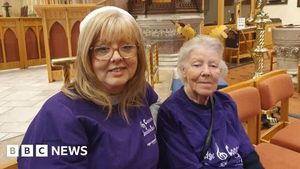In the aftermath of the devastating wildfires that tore through Los Angeles in early 2025, the suburb of Altadena has become a microcosm of heartbreak, resilience, and the complicated process of recovery. The flames, driven by fierce Santa Ana winds, leveled entire neighborhoods and left families grappling with the loss of homes, memories, and—most painfully—the sense of belonging that defined their community. Yet amid the ruins, stories of determination and hope are emerging, as residents weigh agonizing choices about whether to rebuild, relocate, or reinvent what home means to them.
The Eaton Fire, which struck in April 2025, was particularly brutal in Altadena, a historically diverse enclave nestled in the foothills of the San Gabriel Mountains. According to The Washington Post, the inferno killed 19 people and became one of the most expensive natural disasters in U.S. history. On West Las Flores Drive, the epicenter of the blaze, only two of 27 houses remained standing after the flames subsided. The Army Corps of Engineers arrived in early spring to begin the grim task of debris removal—an essential, if somber, step before any notion of recovery could begin.
For Leslie Anderson-Aitken and her son, Daron Anderson, the loss was both physical and emotional. Their home at 295 West Las Flores had stood for more than a century, accumulating milestones and memories. As the excavator cleared away the charred remains, Leslie watched with steely resolve, while Daron, clad in black, struggled to let go. “Now home is just going to be a hole in the ground,” he said, echoing the grief felt by so many in the community (The Washington Post).
The trauma of the fire extended far beyond the immediate destruction. Many residents, like the Valdes family next door, faced impossible financial calculations. With a hefty mortgage, insufficient insurance payouts, and young children and an aging mother to care for, the Valdeses made the difficult decision to sell their property and seek stability elsewhere. “Where else are we going to go?” Dani Valdes wondered aloud as she surveyed the ashes of her childhood home (The Washington Post).
Others, like Jennie Bridges, found themselves in a peculiar limbo. Her house, one of the only ones spared by the fire, was still standing but rendered uninhabitable by toxic smoke and ash. The structure, once a refuge, now posed its own health hazards. Jennie, 78, and her son, who has limited mobility, were forced to wait in temporary housing until it was safe to return. “I’m being torn in 20 different directions,” she admitted, her voice heavy with frustration (The Washington Post).
As families scattered across Los Angeles—living in hotels, Airbnbs, or with relatives—the sense of community that once defined West Las Flores was fractured. Insurance claims, grant applications, and endless paperwork became the new full-time job for many survivors. For Leslie, the ordeal triggered what she called “fire nightmares” and a fog of PTSD. “It’s visceral, it’s gutting, and people are never the same afterward,” said Jennifer Gray Thompson, who leads After the Fire, a nonprofit that supports wildfire survivors (The Washington Post).
Yet, amid the uncertainty, some residents are charting unconventional paths to recovery. According to NPR, Evan Chambers and his family, who also lost their home in the Eaton Fire, are partnering with the architecture firm Omgivning in a historic house relocation project. Instead of building anew, they are moving a two-story 1911 craftsman home—dismantled piece by piece—from another part of LA County to their lot in Altadena. Chambers, undaunted by the challenge, said, “You know, the thought of moving a house, even a house that's, like, super beat up, it's like, oh, yeah, bring it on.”
The project, spearheaded by Omgivning's creative director Morgan Sykes Jaybush, aims to give homes slated for demolition a second life in fire-affected neighborhoods. “We just started cold calling those property owners to see if they would allow us to relocate the house in lieu of them demolishing it and throwing it into a landfill,” Jaybush explained (NPR). While the process is complex—requiring numerous permits, structural inspections, and the expertise of contractors like Dinuba House Movers—only a handful of families have taken this route so far. The costs, too, are daunting: some expect to spend $700,000 to $1 million, a sum comparable to buying a new home in LA County. For many, insurance payouts cover only a fraction of these expenses.
Still, for families like the Chambers, the effort is about more than economics. It’s about preserving character and history, and, perhaps most importantly, reclaiming agency after a disaster that left so many feeling powerless. Chambers said that working on the new (old) house reminds him of the intimacy he felt with his previous home: “I was, like, intimately acquainted with my house. You know, I knew every little nook and cranny and splinter on the wood floors.”
The broader Altadena community, meanwhile, faces a patchwork of outcomes. By September 2025, The Washington Post reported that hundreds of residents had already sold their properties, while others had requested permits to rebuild. A survey of West Las Flores homeowners found 11 planning to return, five intending to leave, and several still undecided. The physical landscape is changing, with “For Sale” signs cropping up and empty lots awaiting new beginnings.
For those who remain, progress is measured in small victories. Jennie Bridges, after months in a hotel, watched as a team of cleaners spent two weeks scrubbing every inch of her smoke-damaged house. “Before, all I could think of was being home, being home,” she said. “Now I’m expanding a little bit. A little bit.” Yet, as she prepared to move back, she knew the neighborhood would never be quite the same. “I know it’s a war zone, but I just want to go home. I’m so sick of looking at the four walls of my hotel.”
For Leslie, the path forward is still uncertain. After losing her private insurance and being left with the state-backed California FAIR plan, she faces a daunting gap between what she received and what it would cost to rebuild. “I want to rebuild,” she said. “But can I?” A glimmer of hope appeared when a nonprofit offered to help, but it soon faded into more paperwork and uncertainty. “Life is not Monopoly,” she quipped, reflecting the bittersweet reality of disaster recovery.
As Altadena’s residents rebuild their lives in fits and starts, their stories are a testament to the resilience required to face not just the flames, but the long, winding road that follows. The scars of the Eaton Fire are visible in the landscape, but also in the daily choices, dreams, and stubborn hope of those determined to call this place home once more.



